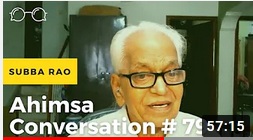Ahimsa
Is violence more natural than nonviolence? http://youtube.com/embed/7H4cw3N1364?start=17&end=117
What is ahimsa? http://youtube.com/embed/7H4cw3N1364?start=118&end=274
How are ahimsa, justice and politics related? http://youtube.com/embed/7H4cw3N1364?start=275&end=356
Why is ahimsa not a mere tactic for protestors? http://youtube.com/embed/7H4cw3N1364?start=357&end=487
Ahimsa and Justice: http://youtube.com/embed/7H4cw3N1364?start=487&end=605 08:07-10.07
Can Ahimsa help to shape the present and future? http://youtube.com/embed/7H4cw3N1364?start=606&end=745
Ahimsa Conversations Live # 1 : Second Anniversary
Ahimsa Conversations Montage # 2
Man's basic aspiration is to be empty of violence. Our Core Nature is Ahimsa. It is full of Karuna (compassion)
and Comradeship. All the violent ways, and violence generating destructive tendencies are delussions.. And they are caused by causes and conditions which are essentially external influences. They are not our basic nature. That is why, to keep our hearts, and our minds in its natural state, would be to maintain Ahimsa
 https://www.youtube.com/watch?v=BTVCSOnwiak 57 mins
https://www.youtube.com/watch?v=BTVCSOnwiak 57 mins
Eighty-five-year-old Mr. Rao, who was born in Bangalore, joined the Quit India Movement when he was 13 and went on to dedicate his life to Gandhian ideals. He has been associated with several organisations including the Student Congress and the Rashtra Seva Dal.
Cultivating physical strength, finding joy in physical labor and being fearless are some of the key qualities for nonviolence. Subba Rao has learnt this over 70 years of holding youth camps on Gandhian ideals of truth and nonviolence, in every state of India and abroad. He has conducted 37 camps in the USA over that many years. Here ‘Bhaiji’, as he is better known, shares reflections on this work including his key role in the surrender of dacoits in the Chambal Valley in the 1950s. There are alternatives to the gun but it is weapons and organized violence that get large volumes of investment whereas nonviolence attracts a fraction of spending. What advocates of nonviolence can build upon is that people across the world are fed up of violence. Thus one day the world will accept that love is the alternative to the gun.
Snippets - https://www.youtube.com/watch?v=BTVCSOnwiak 6.19 Min
What is Ahimsa? A teenager’s exploration Ishaan Rajabali - https://indianexpress.com/article/opinion/what-is-ahimsa-a-teenagers-exploration-7216071/ Today, we find ourselves living in a conflict-ridden world, where differing viewpoints clash in a raging fire stoked by hate and polarisation. The situation is so dire that we seem to have abandoned the search for a middle ground that allows for peaceful discussion... Ahimsa Conversations was born. The idea of journalist and author Rajni Bakshi, this YouTube platform provides viewers with a window into the thoughts of an extensive range of figures who have delved into the varied aspects of ahimsa..
Jai Jagat 2020 2000 km of JJ 2020 Engligh VO https://www.youtube.com/watch?v=eMz82o7pvck https://www.youtube.com/watch?v=eMz82o7pvck
https://www.jaijagatinternational.org/nonviolent-economy-summary/ In the 2021 the Jai Jagat campaign is focusing on some areas for transitioning to a nonviolent economy. These are:
climate mitigation, supporting land and defenders of the territories, stabilizing food security and biodiversity, developing greater access to water through regenerating water bodies, reducing forced migration, and enhancing peace through justice.
The current economic model is largely based on extractivist practices and land grabbing, mainly in Indigenous areas. Therefore, it becomes a priority to secure and protecting land rights and collective tenure rights in order to move towards a nonviolent economy
- promote the transformation of food systems, by supporting small-scale producers, who according to the International Land Coalition, occupy 70-80 percent of farmland and produce more than 80 percent of the world's food worldwide.
- bring nonviolent responses as a way of resisting and transforming those conflicts, which are consequences of the unequal social structure and organization. Thus, Peace, understood as a process of humanization that allows us to recognize ourselves as a unit; as a process in which we can commit ourselves to generate better living conditions for all, not only for oneself -Sarvodaya, Buen Vivir, Ubuntu-, will come from justice and equity.
- Civil Resistance from Gandhi to Present Time
- Financial investments like stocks can realign people’s incentives to have peaceful societies
- Voices Of Peace: Interview with Faisal Khan
- Dalai Lama: Prayers Will Not Achieve World Peace
- Dalai Lama: Prayers Will Not Achieve World Peace
- Ahimsa as Action
- The international conference, “Dismantling Global Hindutva”
- Related articles
- When workplace policies collide with the realities of DEI: Tanuja Gupta e caste issues and her sacking
Subcategories
Awareness of Prejudice
Prejudice shows up in different ways.. More so now, with the unthinking "forwarding" of social media..
